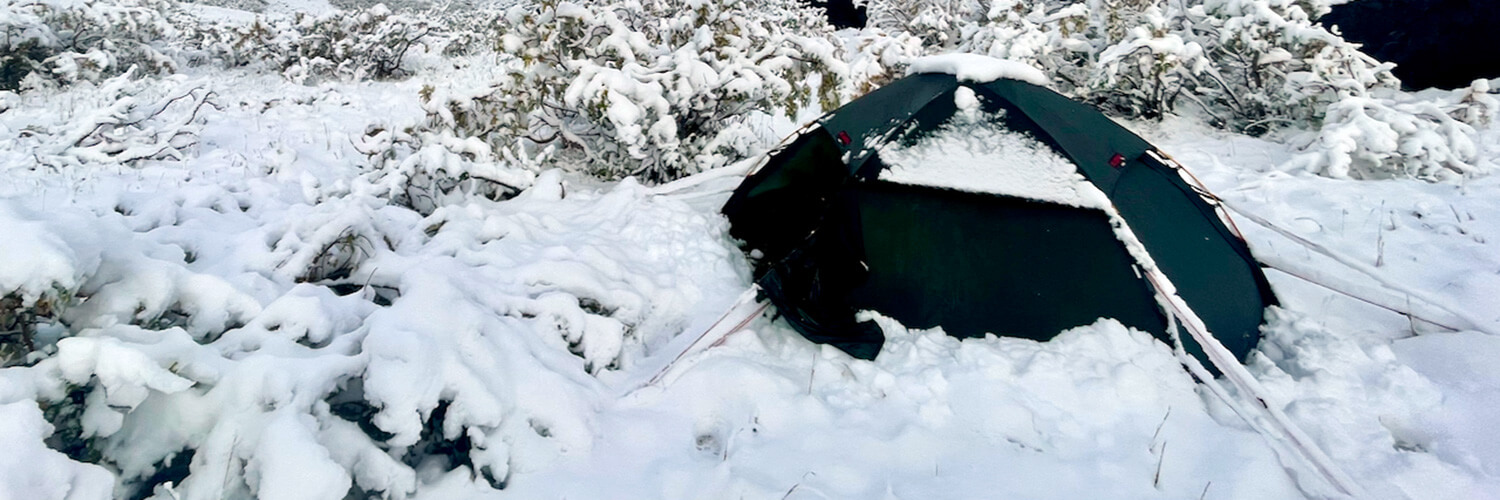There are countless shelters on the market. Tents, tarps, and tipis. Materials such as silnylon, silpoly, and Dyneema. Ultralight options rated for 3-season use, and heavy-duty options rated for 4-season use. Single-wall and double-wall. Freestanding and non-freestanding. And the options don’t end there!
So how do you select the best shelter for your needs? And is there one shelter that can do it all for you?
In addition to watching the video (above, or on YouTube), listen to the podcast below as Steve & Mark discuss the various types of shelters available, the many shelters they have used, and what to consider when selecting a shelter for backpack hunting.
Header Photo: Mark wakes up to a surprise winter storm on a backpack hunt in Alaska.
Key Concepts
- Shelter choice should be determined by hunt style and strategy, topography and terrain, and weather or season
- Having multiple shelter options is beneficial for the serious backpack hunter that hunts in numerous places, across a variety of seasons
- The benefits (and drawbacks) of an ultralight bivy, based on the hunt style and weather conditions
- When a lightweight trekking-pole-supported tent is the best choice for hunters, and what their limitations are
- Why the overall footprint of a shelter is a critical factor to consider on mountain hunts
- How an enclosed shelter creates mental comfort but doesn’t protect you as much as you may think
- The vast differences among traditional (body + fly + pole) tents, in terms of size, weight, and capabilities
- The underestimated downsides of tipi-style shelters, especially for the backpack hunter
- The 5-Pound Rule of Thumb for your shelter and sleep system
- The differences between a 3-season and 4-season shelter, and what a hunter should consider when choosing between the two
- The importance of a shelter’s shape, especially when looking at the internal usable space of the shelter, as well as how that shelter handles wind
- How the pole type and structure affect the livability of a tent, and why single-pole shelters struggle in this regard
- Shelter setup for high wind conditions, including location, direction, and guy-out strategies
- How to think through gear and weapon storage with your shelter choice
- The attributes of common shelter materials, including silnylon, silpoly, and Dyneema (cuben fiber)
- Freestanding vs non-freestanding shelters, and when it matters
- Thinking through the number and type of tent stakes required for shelter setup
- Shelter guy-out strategies without relying on tent stakes
- How (and why) to protect your sleeping pad in a floorless shelter with Tyvek, a polycro groundsheet, or even a bivy
- When a “hot tent” with a stove makes sense, and when it doesn’t
- How to limit condensation, why condensation isn’t just the shelter’s fault, and how to manage condensation when it happens
- Sharing a two-man shelter vs each hunter bringing their own solo shelter
- If we had to own just one shelter for Sep & Oct hunts, which one would it be?
Gear Links
Here are some links to gear mentioned in the video and podcast. Again, everything at The Experience Project is 100% free from advertising or sponsorships…
- Katabatic Pinon Bivy
- Outdoor Vitals Fortius 1P
- Gossamer Gear The One
- Big Agnes Fly Creek
- Tarptent Aeon Li
- Tarptent Moment DW
- Hilleberg Anjan 2
- Hilleberg Niak
Have Questions?
We will be doing Q&A in future podcasts and videos, so let us know if you have a question that we should consider discussing.







